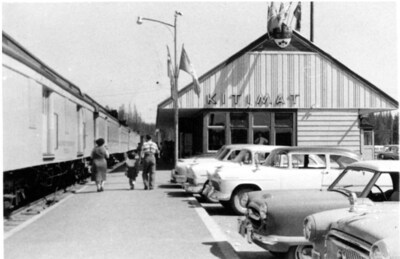Kitimat station supported the transportation of both passengers
and goods, as well as the provision of telegraph and radio
communication services
KITIMAT,
BC, April 29, 2024 /CNW/ - Railway stations in
Canada are recognizable landmarks
that mean different things to different people. They are iconic
structures that represent the links between people, communities,
and opportunities. They are also tangible reminders of colonial
expansion and the impacts infrastructure construction had on
Indigenous communities and the environment. The designation of
Heritage Railway Stations ensures their protection as a means of
remembering the roles that they have played in our shared
history.

Today, the Honourable Steven Guilbeault, Minister of Environment
and Climate Change and Minister responsible for Parks
Canada, announced the designation of Kitimat station under the
Heritage Railway Stations Protection Act. Designated heritage
railway stations are protected from unauthorized alteration, sale,
transfer, or disposal. Heritage railway stations are found in
communities both large and small throughout Canada and represent important aspects of
Canada's history.
In 1955, the Canadian National Railway (CNR) built its station
in Kitimat at the request of Alcan
in order to export aluminum ingots from its nearby smelter site,
import materials, and transport workers and their families. Many
newcomers to Canada from a variety
of geographic and ethnic origins, including Portuguese, Italians,
Hungarians, Greeks, Germans, and Scandinavians, used the railway
line to access jobs and their new life in Kitimat. Although its passenger services ended
in the spring of 1958, the station continued to serve as a
telegraph office until the 1970s.
The building of the station and the Alcan smelting site
significantly impacted local Indigenous communities. The
hydroelectric dam built by Alcan on the Nechako River, flooded
large areas of homelands, forests, farmlands, and recreational
areas, forcing the Cheslatta T'en First Nation to leave their
territory at very short notice with minimal compensation.
Meanwhile, the approximately 200 Haisla people living near the
proposed townsite at Kitimat were
only minimally considered by Alcan planners and managers.
In addition to designating heritage railway stations, the
Government of Canada, through the
Historic Sites and Monuments Board of Canada, recognizes significant persons,
places, and events that have shaped our country as one way of
helping Canadians connect with their past. By sharing these
stories, we hope to foster understanding and reflection on the
diverse histories, cultures, legacies, and realities of
Canada's past and present.
The designation process under Parks Canada's National Program of
Historical Commemoration is largely driven by public nominations.
To date, more than 2,240 designations have been made nationwide. To
nominate a person, place or historic event in your community,
please visit the Parks Canada website for more information:
https://www.pc.gc.ca/en/culture/clmhc-hsmbc/ncp-pcn/application.
Quotes
"Serving as a vital connection on the Canadian National Railway
line, Kitimat station transported passengers and goods, provided
important communication services, and supported the local economy.
The construction of the site, and associated infrastructure
development, also had resounding impacts on the Haisla and
Cheslatta T'en First Nations. It is only through sharing the
whole story, that we recognize and appreciate the truth of our
shared history with Indigenous peoples. Heritage designations
reflect the rich and varied perspectives of the story of
Canada, and I encourage all
Canadians to learn more about the Kitimat Heritage Railway
Station."
The Honourable Steven Guilbeault
Minister of
Environment and Climate Change and Minister responsible for Parks
Canada
Quick Facts
- Kitimat is in the territory of
the Haisla people and is located at the head of the Douglas
Channel, about 800 km north of Vancouver. The Haisla, meaning "dwellers
downriver," have occupied their traditional territory since time
immemorial, living off the land and water resources of their
territory. The Haisla village of Kitamaat is located south of the
town of Kitimat.
- The Kitimat station illustrates the mid-twentieth century
modernization of CNR's approach to architecture and branding in its
fusion of Modernist architectural characteristics with attributes
common to historic CNR stations and domestic architecture.
- Since the Heritage Railway Stations Protection Act was
proclaimed into law in 1990, over 150 heritage railway stations
have been designated across Canada. The Historic Sites and Monuments Board
of Canada, with support from Parks
Canada, evaluates eligible railway stations based on criteria such
as architectural and historical significance and then makes a
recommendation for designation to the Minister responsible for
Parks Canada (Minister of Environment and Climate Change).
- Created in 1919, the Historic Sites and Monuments Board of
Canada advises the Minister of
Environment and Climate Change regarding the national significance
of persons, places, and events that have marked Canada's history. Together with Parks Canada,
the Board ensures that subjects of national historic significance
are recognized under Parks Canada's National Program of Historical
Commemoration and these important stories are shared with
Canadians.
Associated Document
Backgrounder: Kitimat Heritage Railway
Station
Related Links
Parks Canada
Heritage railway stations of Canada
Historic Sites and Monuments Board of Canada
Framework for History and Commemoration
SOURCE Parks Canada (HQ)